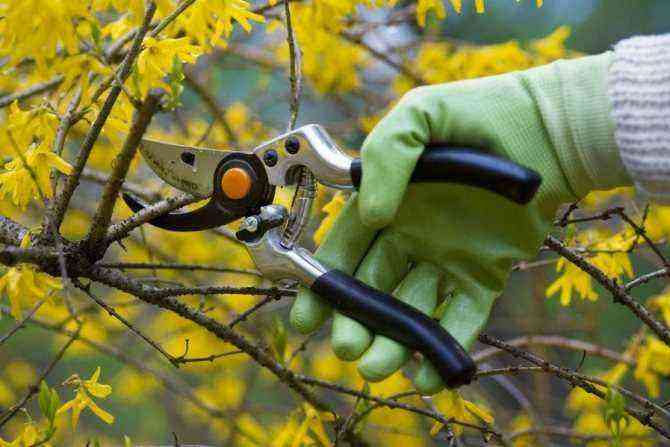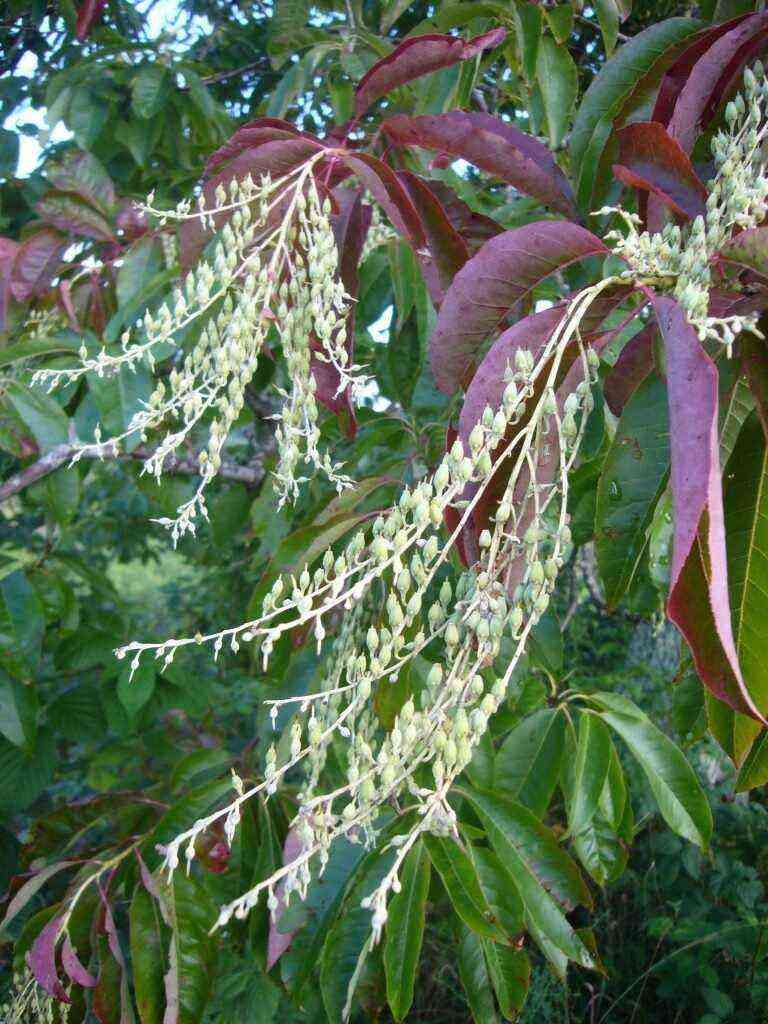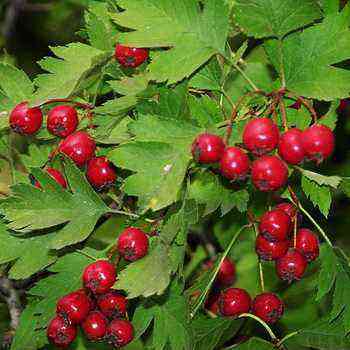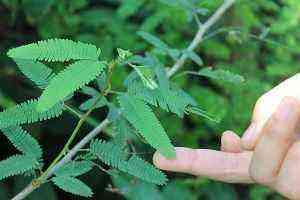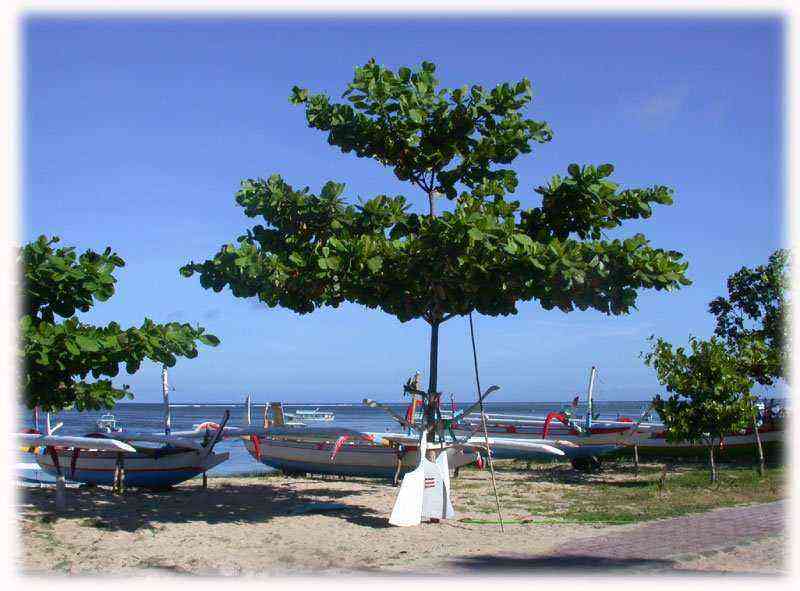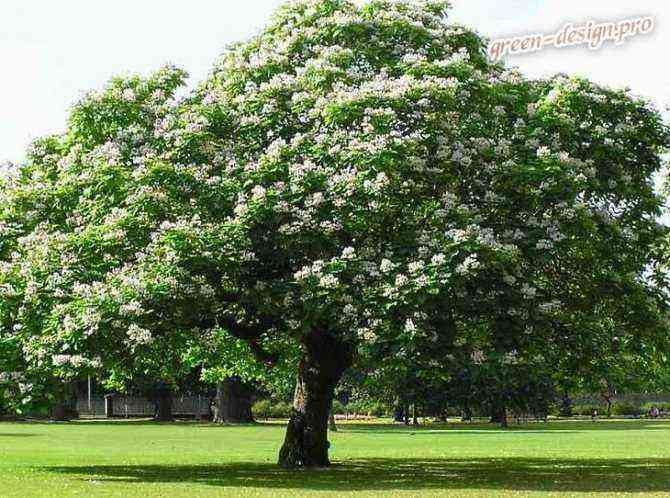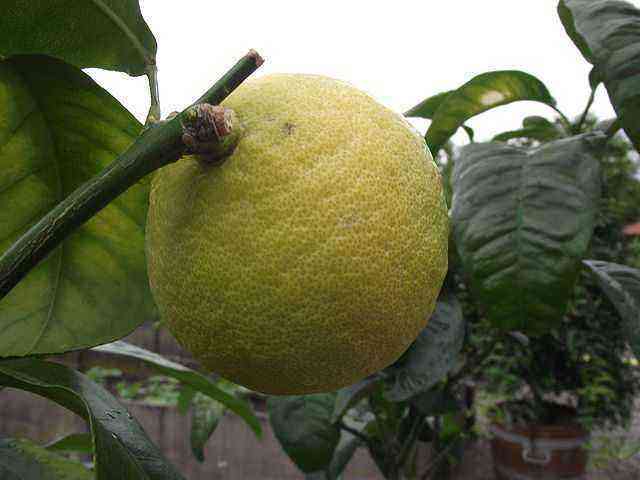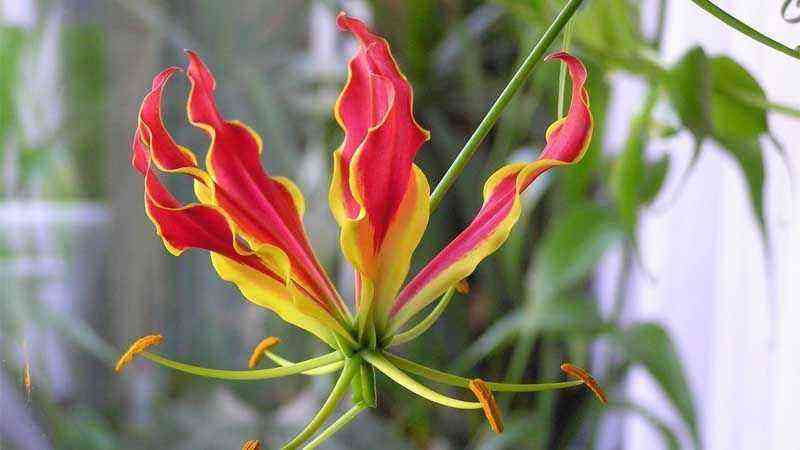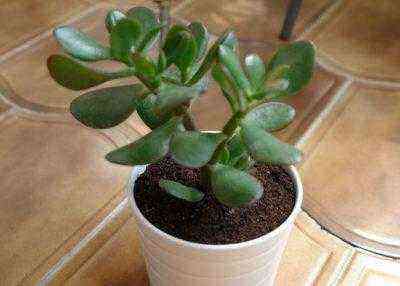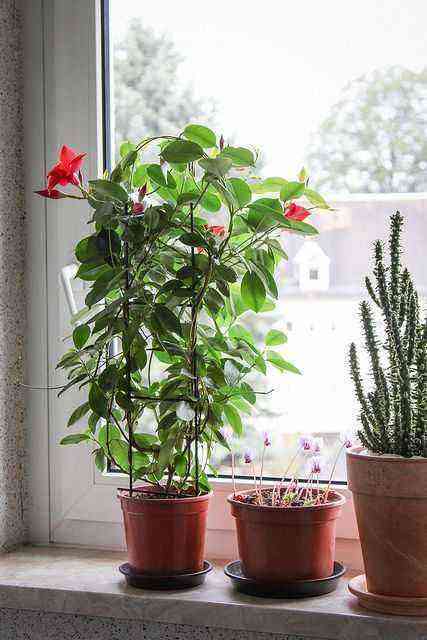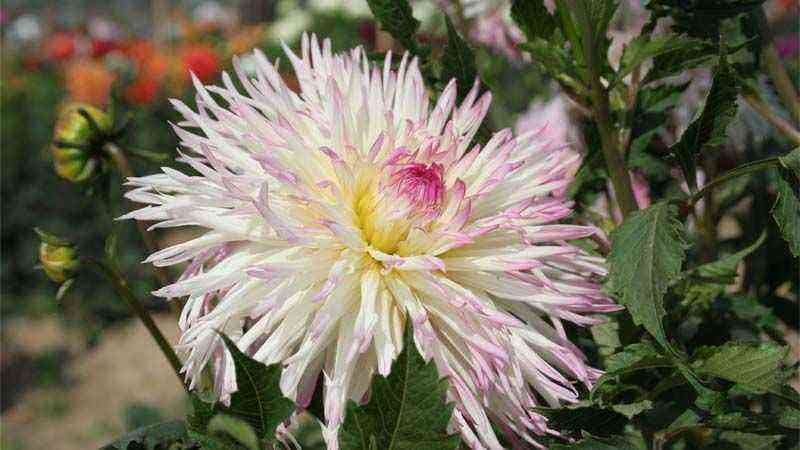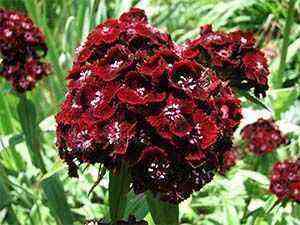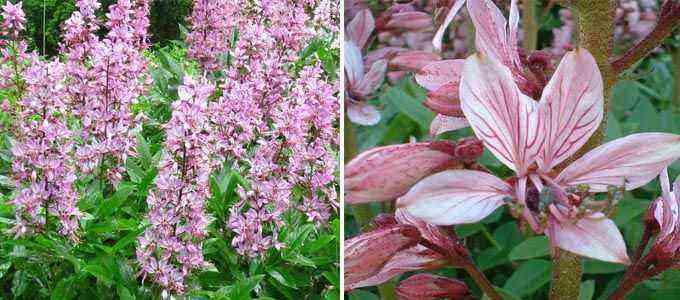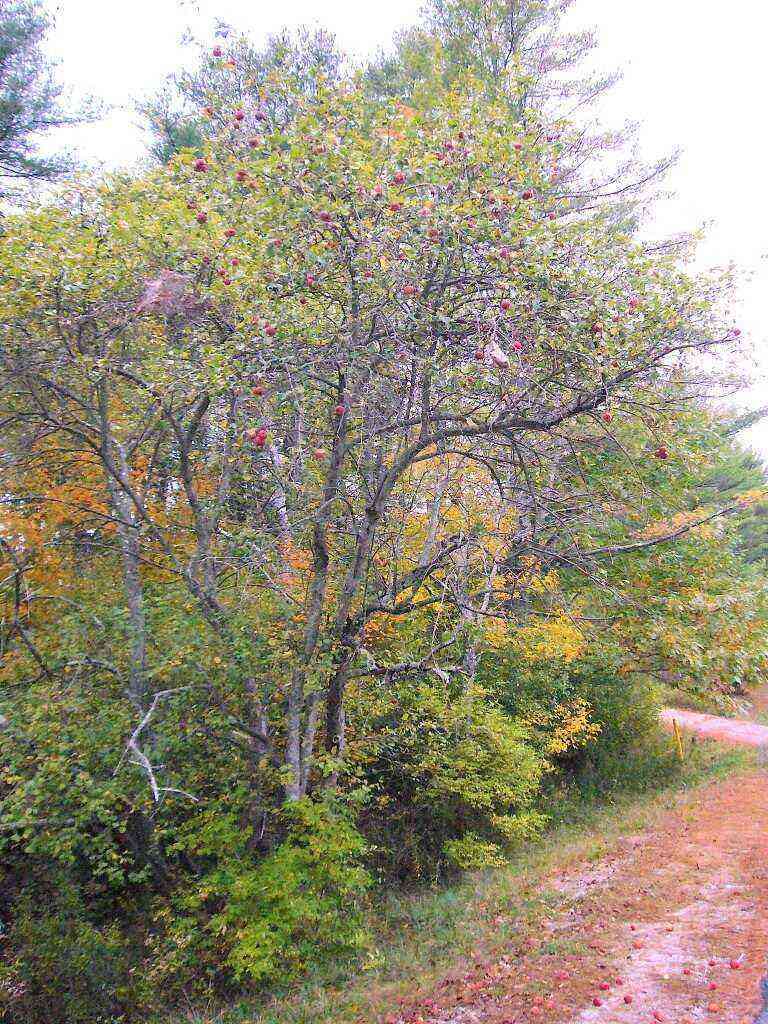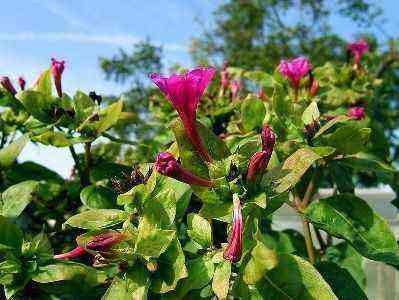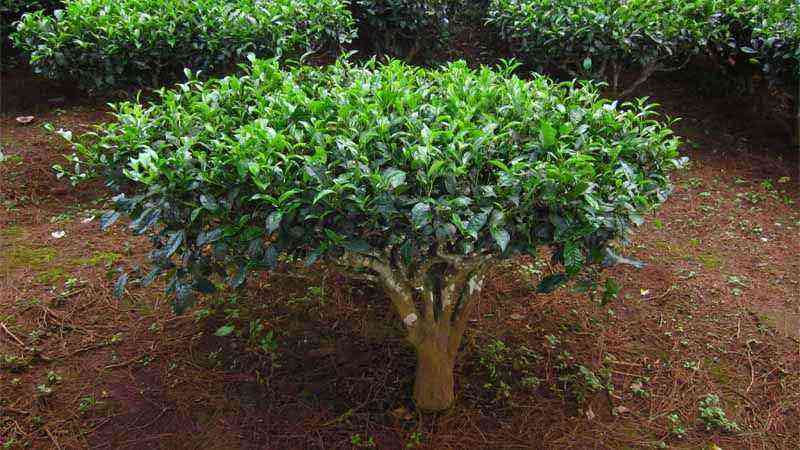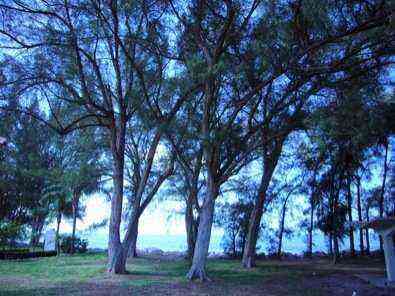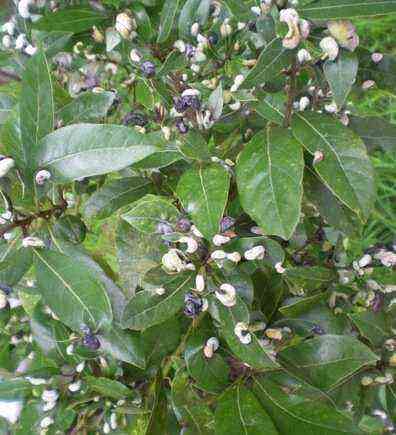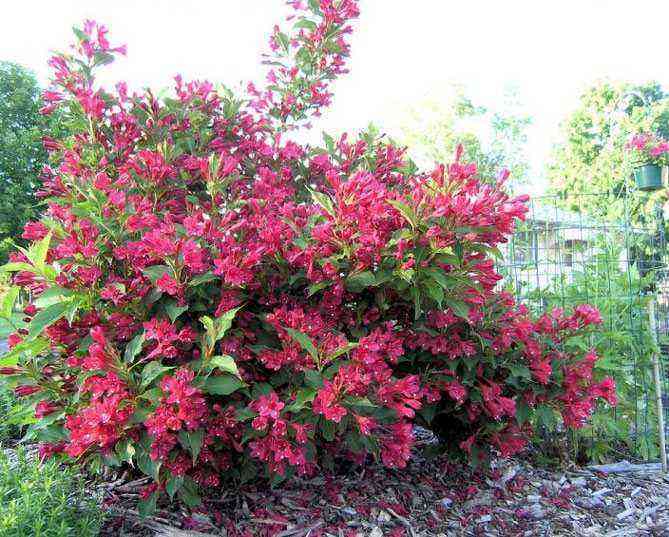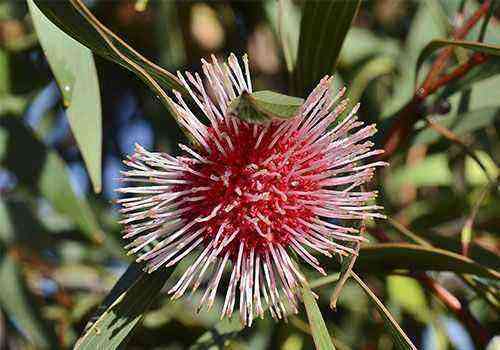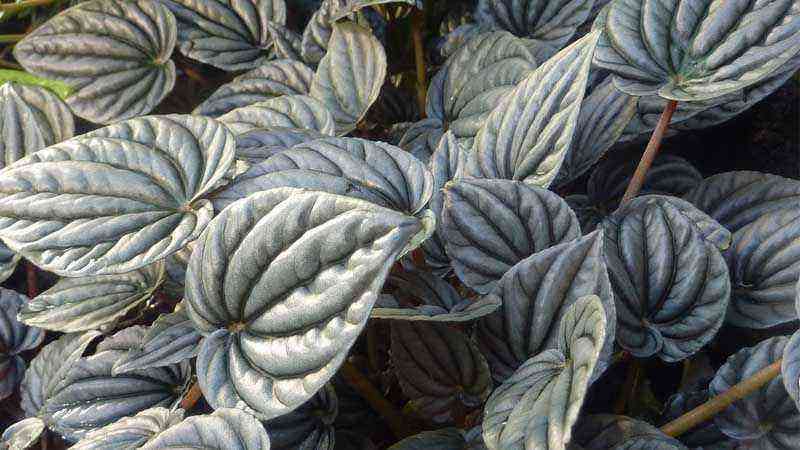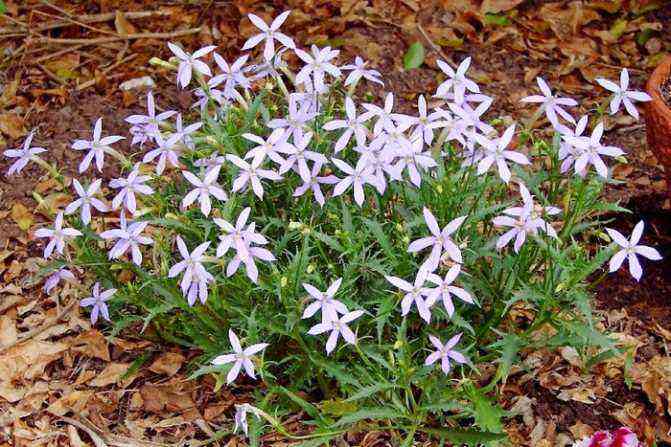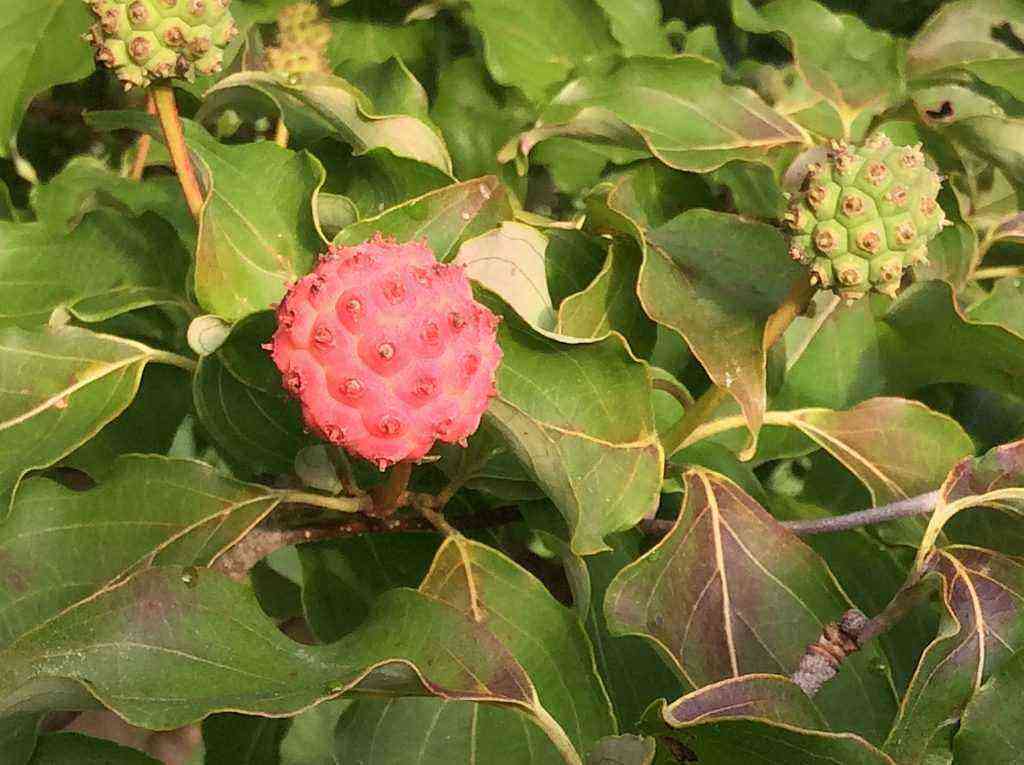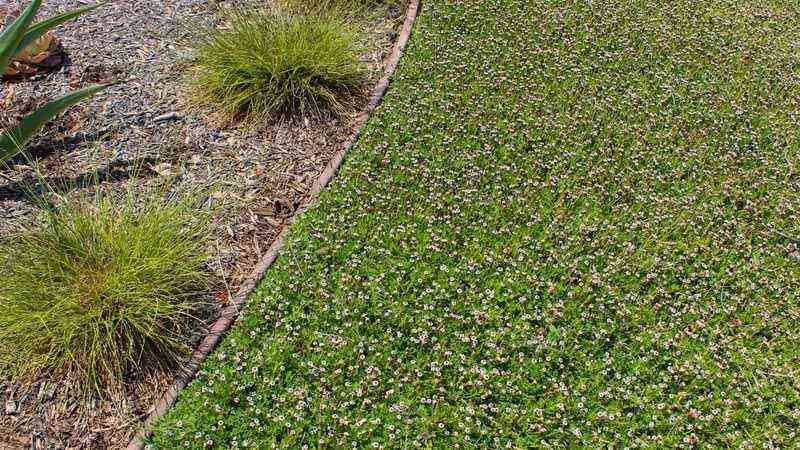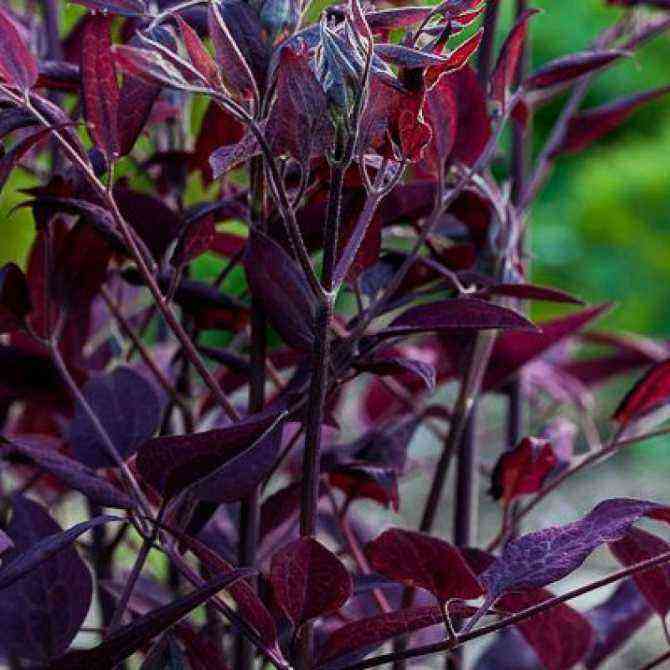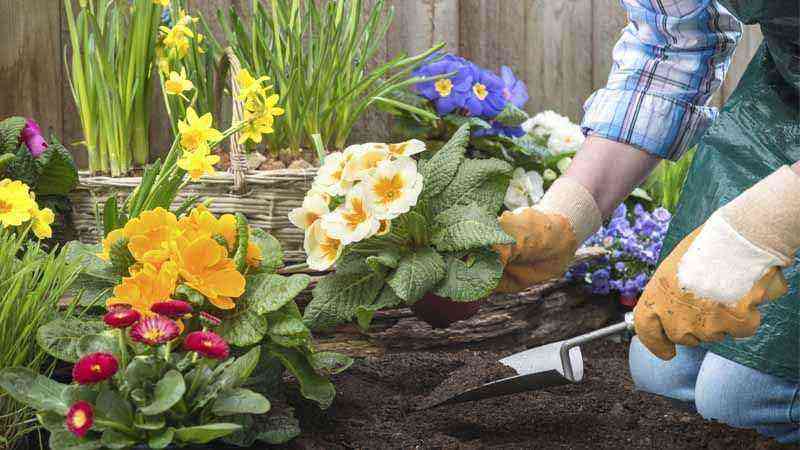When you first see a blooming forsythia (forsythia) bush in spring, you will definitely be eager to grow the same one on your site. Still, she is a bright spring antidepressant!
Like all flowering shrubs, forsythia needs your care before winter comes. And although the damaged crown of the bush is recovering, the stress from low temperatures can affect flowering, which will not be so abundant or even not start at all. In addition to this, the shape of the bush may deteriorate in the frozen forsythia.
What types of forsythia are least afraid of winter
Let’s clarify, just in case, how different varieties of shrubs tolerate negative temperatures.
| European Forsythia / Forsythia europaea | For the winter, you need to hide from the cold in a frost-free room |
| Forsythia intermediate / Forsythia x intermedia | Frost-resistant, but harsh winters can damage shoots or flower buds |
| Forsythia snowy, or white / Forsythia abeliophyllum | Despite its name, this type of forsythia cannot be called frost-resistant. |
| Forsythia ovoid (oval) / Forsythia ovata Forsythia hanging (drooping, or drooping) / Forsythia suspensa Forsythia Siebold / Forsythia Sieboldii | The most unpretentious and frost-resistant |
Winter-hardy varieties of forsythia for the Moscow region
For the climatic conditions of the Moscow region, winter-hardy varieties of forsythia should be selected:
- Egg-shaped (oval) – the most suitable option, which differs not only in resistance to cold, but also to drought. It grows up to 2 meters in height, it is distinguished by a gray bark with a yellowish tinge. It blooms for 15-20 days. Moreover, by autumn, the leaves turn from bright green to orange. It is interesting that many gardeners do not even cover it for the winter, but it is better to cover young seedlings with spunbond.
- A variation of the previous variety – Tetragold – is also characterized by increased winter hardiness. This species is suitable for lovers of miniature, lush plantings, since it grows no more than 1 meter.
- The recently bred Melisa variety, which is similar in properties to Tetragold , is compact – it is well suited for small areas.
- The Siebold Forsythia also tolerates winter very well, so it does not need additional shelter – you just need to mulch the trunk. The shrub is undersized, its shoots spread along the ground. Prefers light shading rather than open areas.
- Forsythia drooping is a rather tall shrub that grows up to 3 meters. But its flowering begins only after 5 years. The shoots are very interesting – they have an unusual olive or brown color. It needs to bend the branches to the ground – in the conditions of the Moscow region, they can freeze a little.
- Forsythia intermediate has about the same height, but begins to bloom from 3 years old. This variety is very often used by gardeners to form a hedge. It does not need additional shelter for the winter.
Also read: Technology for feeding tomato seedlings at home
Watering and feeding forsythia in the fall
Watering for forsythia and summer is far from the first thing. The shrub needs additional moisture only in drought or if it grows on sandy soil. In autumn, only water-charging irrigation is enough.
In advance, but no later than the end of August, feed the forsythia with a mixture of mineral fertilizers rich in phosphorus and potassium. Exclude nitrogen. If the soil is too poor, feed with nitrogen fertilizer in the spring.
Late nitrogen fertilization can cause increased growth of the shrub and the appearance of shoots unwanted on the eve of cold weather.
Features of preparing forsythia for winter
In order to properly prepare the shrub for the winter period, you need to take into account a few simple rules for pruning, sheltering forsythia and other measures to guarantee successful wintering.
Also read: Maiden grapes: features of reproduction, planting and care in the fall
Autumn pruning forsythia
Any gardener who decides to grow this attractive shrub should possess the skills of pruning forsythia, because it is thanks to this procedure that its lush, attractive shape can be constantly maintained. And autumn pruning also serves as an additional measure to preserve the plant during the winter period. The pruning technology during this period is quite simple:
- First of all, dead branches are removed, dried, with cracked bark, as well as shoots that are too long, which stand out significantly against the general background.
- Next, remove all branches that are too close to the ground. Although a few of them can be left to root and propagate by layering (for more details, see the corresponding section). Then transplant the offspring, and remove the rest of the shoot.
- All branches that grow towards the center, as well as intertwining, located too close, are also removed completely: they will interfere with each other and spoil the overall appearance.
PLEASE NOTE
Such procedures are performed every season, and ideally, it is better to prune immediately after the forsythia blooms.
Autumn pruning also serves as an additional measure to preserve forsythia during the winter period.
Shelter forsythia for the winter
It is imperative to cover forsythia for the winter. Moreover, additional protection measures are used even in cases when it comes to winter-hardy varieties. The only exceptions are the southern regions of the country – Kuban, Stavropol, the Caucasus and Crimea. The sequence of actions is as follows:
- First, the shrub must be watered abundantly – especially if it was planted this season.
- Further, the ground around the seedlings must be mulched with dry foliage and needles – the layer is at least 10 cm.
- Then the branches are bent to the ground and pinned.
- Further, the shrub is covered with spunbond and other material that allows sufficient moisture and air to pass through.
- The material is pressed down with heavy objects – it is better to find as many stones as possible, since the forsythia branches are quite elastic.
Also read: Cotoneaster: description of species, planting and care features
PLEASE PLEASE ATTENTION
You should not use polyethylene – otherwise the flower shoots will mate during the thaw, which will negatively affect the growth and flowering of the shrub.
How to form a forsythia crown (video)
Other types of care for forsythia in the fall
Other measures to prepare forsythia for the winter period include mulching and fertilization. Basically, they are the same thing because the mulch around the root collar is formed from the humus from the compost. You can add dry foliage – ideally, the layer should be 10-15 cm in height.
Mineral fertilizers do not need to be applied – the plant is preparing for a dormant period, therefore, such dressings are applied only in spring. However, if the soil is too poor, you can fertilize with organic matter.
Pruning and propagation of forsythia by layering
In the process of autumn pruning (first-year bushes do not need pruning), remove excess, damaged shoots, dried and diseased branches from forsythia. Pruning is also a kind of “combing” necessary for the growing plant to remain in decorative form.
Take the foliage from the cut young shoots of forsythia, put the twigs in the refrigerator in a paper bag. In February, immerse the shoots in warm water (30-35⁰C) for 4-5 hours. Then put in water at room temperature, adding 50 g of sugar to 1 liter of water. After 2 weeks, the twigs will bloom.
Thin the shrub closer to the roots, removing shoots near the ground to keep the plant free of harmful insects. A few low-growing branches can be left for rooting. Pin the layers and sprinkle with earth, in the spring they will give roots. Propagate forsythia in this way (similar to propagation of currants and gooseberries) until the beginning of September, in the south – until the end of the month. Prune in time so that the shrub will come to its senses before the cold weather, i.e. the slices had time to tighten.
Do not get carried away with autumn pruning forsythia: the fewer branches you remove, the better the shrub will feel in winter.
Forsythia bloom
During the flowering process, forsythia will not leave anyone indifferent. During this period, due to the abundant flowering, the shrub is completely covered with flowers of golden yellow shades, which resemble bells in shape. The appearance can be simply mesmerizing. After the flowering period ends, the shrub does not lose its attractiveness. Bright colors are replaced by bright foliage, which has a rich green color.
How forsythia blooms
Forsythia is an early flowering shrub, reaching a height of up to 2 m. The leaves are large enough, they can be simple or trifoliate, opposite, in some cases they can be serrate at the edges, have a rich green color.
In the process of flowering, bells of a rich golden color appear. The flowers are the same size, the branches are densely strewn. As a rule, the shrub begins to bloom in early spring and this continues until the leaves appear. In regions with low temperature conditions, it is likely that some of the buds will die, and flowering will not be so abundant or not at all. Therefore, it is recommended to cover the plant for the winter.
After flowering, forsythia turns into a bush with leaves of different shades and remains in this form until autumn, after which the next phase begins, during which the shrub begins to fade. At the moment when forsythia begins to prepare for winter, it throws off all the leaves, changing its color. Despite the fact that after flowering forsythia loses its attractive appearance, in autumn the leaves acquire bright and varied shades. In autumn, foliage can be not only yellow, but also purple, burgundy.
We offer you to familiarize yourself with: Pickled bitter pepper for the winter in Georgian: Tsitsak recipes with photos
There are several reasons why forsythia does not bloom:
- the soil is quite heavy, saline (in such conditions, the shoots are poorly developed, the growth of the shrub is slow);
- stagnation of water is observed in the hole;
- the process of pruning and forming a bush was incorrectly carried out;
- deficiency of nutrients in the soil;
- kidneys froze in winter;
- pests appeared.
If these problems are eliminated, then flowering occurs in 85% of cases. If, after carrying out all the measures to eliminate the problems, forsythia also grows slowly, then it is necessary to add potassium dressing.
Mulching forsythia shrub
Mandatory prevention of hypothermia is mulching. The most suitable option for the root area of forsythia is mulching with humus. Make sure that the layer at the root collar is 15 cm.
What else can you mulch forsythia shrub:
- peat;
- fallen dry leaves;
- hay;
- straw;
- dried river sand;
- bark, sawdust.
Even before mulching, remove weeds from the trunk circle, loosen the soil by letting air in to the roots.
Features of care for forsythia in the fall
Forsythia can be propagated not only vegetatively, but also with the help of seeds. As a rule, seeds ripen at the end of October. Germination and maturation takes place in bolls that appear after flowering. There are several ways of vegetative propagation:
- cuttings;
- layering;
- dividing an adult bush into parts.
Thanks to this variety, every gardener can choose the option that suits him. The easiest way to reproduce is by dividing the root system.
This type of reproduction involves the use of several types of cuttings:
- green;
- summer woody;
- autumn woody.
The harvesting of green cuttings is done in June. The length of the cutting is up to 1 to 2 internodes. A slant cut is made from above, a straight cut from below. The resulting cuttings are placed in water with the addition of the rooting agent for 3.5 hours. After that, they take boxes filled with sand and plant cuttings up to 5 cm deep, while the soil should always be moistened. A month later, the root system is formed.
Reproduction using lignified cuttings differs only in the time of harvesting the planting material. A similar method is used by gardeners of the Southern regions. Harvesting is carried out in the second half of summer or in autumn. Further actions in both cases are similar.
Attention! It is necessary to propagate forsythia by cuttings in the spring.
Most often, seed propagation is used when it is necessary to obtain a large number of forsythia bushes. Seeds are harvested in October, after which they are kept for 2 months at a temperature of 2 ° C to 5 ° C, this is required to undergo stratification.
At the end of March, seeds are sown in a greenhouse or in small containers filled with nutrient soil. To maintain the required temperature conditions, containers with seedlings are covered with cling film.
After 20-40 days, the first shoots begin to appear. As a rule, the germination rate is low and amounts to a maximum of 40%. Growth is rather slow, after a year the height can vary from 2 to 8 cm. Planting is carried out at 3 years, when the forsythia reaches a height of 80 cm. Flowering occurs after 6 years.
Reproduction by layering is the simplest and easiest way. Forsythia has one peculiarity – the branches in contact with the ground begin to take root. Since this method spoils the attractiveness of the bushes, such reproduction is carried out forcibly.
In the spring, young shoots are bent to the ground, making small grooves and fixing the branches. The depth is 10 cm, the leaves are removed along the entire length of the branch, leaving them only at the top. The rooted shoot will be fully formed in the spring. Flowering using this propagation method occurs after 1 year.
Reproduction by dividing the mother bush into parts is the most common way to propagate forsythia. As a rule, an adult bush is completely dug out of the ground. The work must be done carefully so as not to damage the root system. The roots of the bush are divided into several parts, after which each part is treated with garden varnish and planted. At first, care should be constant, after 3 weeks they begin to care for the bushes in the same way as for adult plants.
Shelter forsythia for the winter
Take care of the forsythia insulation, do not rely on the mercy of winter and the cold resistance of the plant. Bend the branches to the ground, then pin them with staples. Take some time to do this before the onset of cold weather – while the branches remain flexible.
Use a breathable cover material, exclude polyethylene or roofing felt. Otherwise, during the thaw, as a result of the greenhouse effect, the kidneys will vomit. The use of a covering material, such as spunbond, will protect not only from frost, but also from winter temperature drops.
The next step is to fix the covering material with stone “anchors” – the elastic branches of the bush can spring back at any time.
With another method of insulation, forsythia is left in a natural position. A frame is placed around the bush, which is covered with the same breathable covering material.
Frost-resistant forsythia species (ovoid, drooping and Siebold) do not need to be protected in winter. But during the spring cold snaps, cover them with spunbond so that the frost does not damage the awakened shoots.
Plants are covered or wrapped with white non-woven material. Black material is laid on the soil to protect plants from weeds and insects.
How to plant forsythia in the suburbs
Planting and caring for forsythia shrubs in the Moscow region is no different from planting plants in other regions. The first step is to prepare a landing pit, the depth of which is 60 cm and a width of 50 cm, broken brick, drainage and sand are poured into the bottom of the pit, in total, the layer height should be 10 cm.
When planting in groups, a distance of 1.5-2 m is observed between the bushes. When planting in open ground in autumn, the soil is mulched, which will protect the young forsythia from weeds, overdrying and low temperature conditions.
Growing forsythia is not as difficult as it might seem at first glance. The main thing is to know the features of the shrub, to prepare the planting material and soil for planting in advance. As you know, the plant is unpretentious, can grow on any soil, but acidic soil is extremely undesirable.
If the soil is acidic, then it is necessary to add about 500 g of furnace ash to each hole prepared for planting a plant, having previously mixed it with fertile soil. Clay soils will require drainage. As a rule, they begin to plant in spring or autumn, until the cold weather sets in.
Seedling preparation
If the seedlings were obtained from cuttings, then they are planted the next year after they have been cut and formed a root system. If you plan to purchase seedlings, then you should pay special attention to this moment. The purchased plants must not be damaged, the root system must be developed.
To plant a bush, you will need to dig a hole, the size of which is 50 * 50 * 60 cm, the root system will be at a depth of 40 cm.If a group planting is planned, then the distance between the bushes should be 1.5-2 m.
As a rule, a drainage layer is laid on the bottom of the pit, which takes 10 cm. Expanded clay and broken brick are excellent for these purposes, sand is poured on top of it. Only after the pit has been prepared can a bush be planted, tamped down and watered abundantly.
If the plants are planted in the spring, then they do not need special care, but the autumn plantings will have to be mulched. The material used for this must be breathable to prevent the kidneys from pounding.
Attention! Care must be taken to prepare forsythia in the fall for winter.
The care process involves timely measures:
- watering;
- pruning;
- application of fertilizers;
- weeding;
- loosening of the soil;
- mulching.
Every time after watering, you need to take care of the soil in which the forsythia grows. For this, the soil is loosened, weeds are removed. To prevent the growth of weeds, the soil around the shrub is mulched.
Both adult and young bushes are subject to sanitary pruning. In the process of pruning, old, damaged and excess branches are removed, which tend to the ground, of course, if you do not plan to propagate forsythia by layering.
Important! It is recommended to apply fertilizers 3 times per season.
Watering and top dressing
If there is a balanced rainfall, then there is no need to water forsythia. With prolonged hot weather, it is necessary to water the plants every month, using about 14 liters of water for each bush.
During the season, fertilizing is applied 3 times:
- 1st – in spring, after the melting of snow has ended. Rotted manure or mineral fertilizers must be put under the bush;
- 2nd – after the end of flowering for each square. m make 110 g of the drug “Kemira Universal”;
- 3rd – the last time fertilization is applied 1 month before the shrub is sent for wintering.
If you adhere to these recommendations, then forsythia will delight you with its appearance for a long time.
As a rule, the time for transfer depends entirely on the specific region and weather conditions. Increasingly, forsythia with a closed root system can be found on sale, but if it is open, then transplanting is best done in the spring, when there is no threat of frost, or in the fall, before the onset of cold weather.
We suggest you familiarize yourself with: Salting cabbage for the winter with apple cider vinegar
It is important to understand that the periods of planting forsythia in the Moscow region and Siberia will differ significantly. In the Moscow region, plants are planted earlier, since the heat comes faster.
To understand the beauty of the shrub, you can see what forsythia looks like in the fall in the photo.
Forsythia is covered for the winter in order to prevent freezing of the bush. So that in winter the plant does not freeze and die, it is necessary to protect the roots first. For this, the near-trunk circle must be covered with dry foliage, the layer thickness must be at least 10 cm, young bushes must be completely covered, using spruce branches for this.
To preserve the buds, the bushes are bent to the ground. These works are done before the onset of cold weather, while the bushes still have flexibility. The bent shrub is pinned and covered, spruce branches are great for this. In this form, the plant is not afraid of any frosts. In early spring, spruce branches and dry leaves are harvested.
Autumn propagation of forsythia by cuttings
Above, there is a method for propagating forsythia by layering, but a more suitable option for autumn is propagation by cuttings. Cut off the intended lignified branches and divide them into cuttings 15-20 cm long. Plant them in containers filled with moistened soil so that several buds are in the ground – they will take root. Sprinkle with dry foliage and store the containers in a cold greenhouse for the winter. Plant outdoors next summer or fall.
The reason forsythia may refuse to bloom in spring is not necessarily due to improper fall maintenance. Once again, make sure that a good place is chosen for the shrub – it loves sunny places and does not react well to getting wet. Affects flowering and improper pruning or its complete absence. Do not forget about spring feeding – it gives the plants strength after winter dormancy.
Features of planting and caring for forsythia in the Urals
The colorful blooming beauty can be propagated in various ways, but the most effective of them is cuttings. The procedure can be carried out in summer, spring or autumn. Consider the autumn method, because next spring you will be pleased with young seedlings.
To propagate forsythia by cuttings, it is necessary to cut off sufficiently mature, lignified processes about 20 cm long in October, stick them into the ground (depth – 10 cm) and cover with dry leaves or spruce branches. The probability that the seedlings will give roots is not 100%, but it is quite high, and some of the cuttings will definitely take root in the soil.
Despite the fact that forsythia is generally not a very whimsical plant, it, like any other inhabitant of the garden, should be given attention and care should be taken that the shrub does not grow too much and does not die in the first winter. The autumn procedures for preparing forsythia for the cold will not take much time, but will prevent a possible sad outcome for the plant.

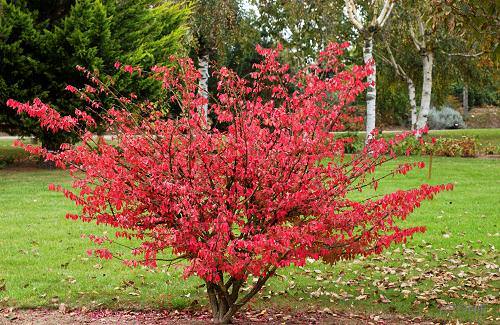
Newly planted plants are quite vulnerable, even if they are hardy varieties. Like adult shrubs, they need thorough preparation for the winter season, without which the chances of survival are close to zero. No pruning is required for the first year of plant life – this will significantly save your time. A mandatory procedure is mulching the root area with humus and sheltering shrubs.
You can cover a young forsythia with branches of spruce branches or any covering material, the main thing is to cover the whole plant as a whole, and not just the roots. To do this, you will first need to bend the branches to the ground and pin them, and then start covering. Remember: for these purposes, you cannot use an airtight plastic film, otherwise you risk depriving the plant of flowering due to the fact that the buds can dry out during the thaw. In extreme cases, forsythia under such material can rot.
Now you can be calm – under the layer of leaves and snow forsythia is not afraid of any cold!
We suggest you familiarize yourself with: How to salt tsitsak pepper for the winter
For such ornamental shrubs as forsythia, pruning is a mandatory procedure, since the plant tends to grow rather quickly and lose its beautiful shape. In addition, all sick, frozen, dry and improperly growing branches need pruning. Autumn pruning is usually done to remove excess and damaged shoots.
Attention! Treat pruning with care and responsibility. If you get carried away with this activity and strive to rejuvenate the plant as often as possible, then the bush will grow well and actively, but you will hardly see inflorescences on it.
If it is planned to plant forsythia in Siberia, then it is necessary to provide the shrub with proper care, only in this way the plant will delight with its appearance. In Siberia, forsythia is planted in places with little shade. It is also necessary to ensure that the chosen landing site is protected from the wind. Often, shrubs are planted near buildings or trees.
Soil enriched with trace elements is ideal; humus is usually used for these purposes. Stagnation of moisture is not allowed, so the soil should be loose and allow air to pass through well. If the soil is acidic or heavy, then it should be prepared in advance for planting forsythia.
Attention! If you do not provide proper care and allow stagnant groundwater, then forsythia can die.
For each region, there are certain conditions for growing shrubs, so it is necessary not only to familiarize yourself with the photos of forsythia, but also with the rules of planting and care in the Urals. In the Urals, shrubs are planted in light soil, which is rich in humus and leafy soil. To lighten the soil, you can use expanded clay or river sand. It is important to understand that forsythia does not tolerate acidic soils.
The planting depth is about 70 cm, drainage up to 20 cm high is laid on the bottom of the pit, for this they use:
- broken building bricks;
- expanded clay medium fraction;
- sand.
To make the shrub grow faster, they use top dressing and fertilizers, which are applied in the spring. Forsythia loves dry soils, so it is not recommended to overmoisten it.
Advice! The distance between the bushes should be 2 m.
Forsythia – outdoor care
It is easy to care for forsythia, it is enough to water in a hot and sultry summer, and if it rains in summer, then this moisture will be enough for the shrub. In addition, the soil around the trunk must be loosened, weeds removed, the soil fed and the crown trimmed.
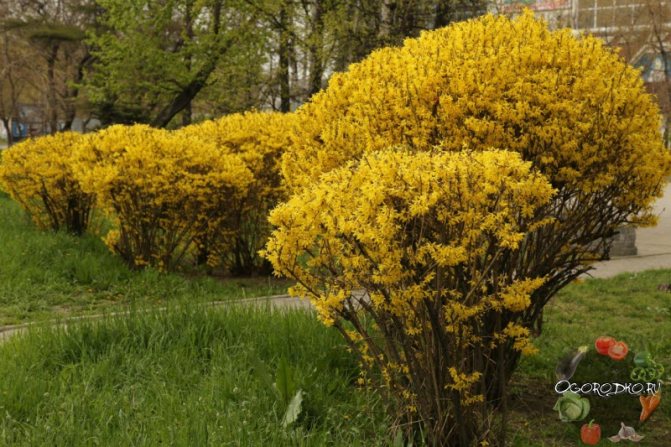
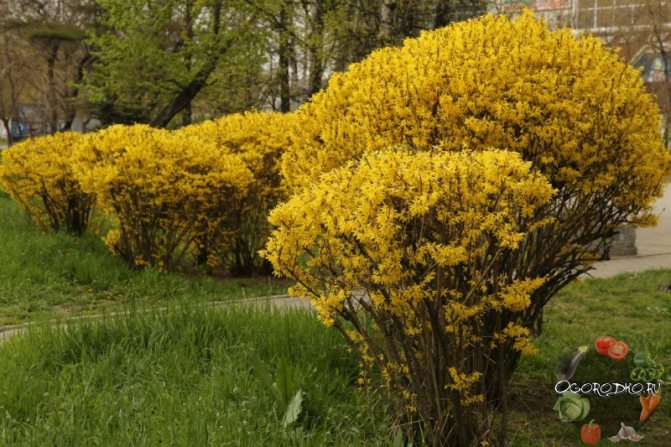
How to feed forsythia? Top dressing is good to carry out three times per season. The first time – before flowering, spread the humus around the trunk and water. The second time – before the flowering period, you will need mineral fertilizers, use any complex one. The third feeding is done with any universal fertilizer and is necessary after flowering, since it is at this time that new buds are laid for the next spring.
If you are wondering how to trim forsythia, then below are some professional gardening tips. Young forsythia bushes do not require pruning in the first years of growth, with the exception of frozen and broken branches.
After three to four years have passed, it is worth starting to prune the plant. Pruning the forsythia shrub in the spring, after the flowering period, is needed in order to give the bush a beautiful shape. Shorten young shoots one third of their length. Prune old shoots more so that only a stump remains, from which new branches will grow. Also, be sure to cut off the branches that are creeping along the ground, otherwise they will quickly take root. The next pruning should be done in early fall to remove damaged branches and stimulate new shoot growth. After the autumn pruning, the bush will have time to recover by the new flowering period.
Uncropped forsythia will stop blooming after a few years, therefore, along with the annual trimming of the shrub, the plant needs to be rejuvenated every four years. Cut all branches 2/3 and leave only a short stump. Thanks to this manipulation, many young twigs will grow, and forsythia will bloom luxuriantly and profusely.
Planting forsythia
Forsythia seedlings are planted in autumn , choosing sunny, calm places and taking into account the characteristics of each variety. However, she can feel great in partial shade, so it looks appropriate under the windows of a country house.
Forsythia prefers sunny locations
The golden Asian loves light and fertile soils. The ideal potting mix for it consists of humus, leafy earth and sand in a ratio of 1: 1: 2. Pits for planting are made 60 x 60 cm in size and buried 70-80 cm, observing a distance between them of 1-3 m, depending on the size of an adult plant. The pits are covered by a quarter of a drainage layer – crushed stone or broken brick. Then carefully place the seedling in the hole, sprinkle it with a prepared soil mixture and water it abundantly.
The main varieties and types of forsythia
To date, there is 5 types of forsythia . Each of them has its own individual characteristics and characteristics. Let’s talk about the main ones:
- The forsythia is intermediate – the height of the bush reaches 3.5 meters . Leaves are oval, their maximum length is 10 cm. Flowers are yellow. The growing season of the shrub is from late April to October. The main advantage of this type of forsythia is its resistance to drought and the ability to survive frost. Grown in central Russia.
- Average fortification – bush height 3 meters . The leaves are large, the flowers are yellow. Some hybrids of this species take root well in the central and even northern regions of Russia.
- Forsythia ovoid is a low-growing shrub with a height of about 1.5-2 meters . The flowering period is 9-16 days. It tolerates the cold well enough, however, it can die during a harsh winter. Suitable for planting in the central and southern parts of Russia.
- European forsythia – shrub reaches 2-3 meters in height . Drought tolerant. It tolerates frost rather poorly, therefore it is distributed mainly in the southern part of Russia.
- Forsythia drooping is a powerful shrub, the height of which can reach 3 meters . It grows only in the southern part of Russia, for example, in the Crimea.
Each type of forsythia includes several varieties. The following varieties received the best reviews:
- Linwood – the height of the bush is 2 – 3 meters. Flowering period 14 days;
- Minigold is a dwarf bush, height only 0.6-0.8 m.;
- Sectabilis is a stunted bush. Height 1 meter. Long enough flowering period – 20 days;
- Goldzauber is a very popular variety. The flowers are large, yellow. It tolerates frost well.
Forsythia seedlings can be purchased from specialized nurseries . The cost depends on the variety. The average price is 350-400 rubles.
It should be noted that forsythia grows best in areas with a mild climate. However, thanks to the work of breeders, there are still varieties that can take root in the Moscow region and even Siberia. The varieties “Tetragold” and “Arnold Dwarf” are just suitable for the Moscow region climate:
- “Tetragold” is a small shrub, which, unlike its counterparts, does not bloom so luxuriantly.
- “Arnold Dwarf ” has a powerful shrub and abundant flowering.
As for the harsh conditions of Siberia, the situation here is rather complicated. Even the most winter-hardy varieties can freeze out in a harsh winter. Nevertheless, you can try to land the aforementioned “Linwood” on your site . It is a winter-hardy variety that can withstand 30-degree frost .
Despite this, for the winter, it is recommended to wrap the shrub with a covering material, which can be bought in specialized stores, or overlaid with coniferous branches.
Description of forsythia
All existing species belong to the Olive family, with similar characteristics. Outwardly, the plant resembles a shrub with yellow flowers. It reaches a height of 1-3 m. The leaves are oval, 15 cm long; during flowering, small flowers appear in the form of bells. Low-flowered inflorescences. The color can be very diverse: from light yellow tones to dark orange.
Flowering continues until the leaves begin to bloom, and lasts 20-40 days. The fruits resemble an elongated capsule with winged seeds. The shrub loves light, quite unpretentious. Today there are several dozen varieties that differ in characteristics, size and color.
Important! In winter, if there is not enough food for the birds, they can peck on the kidneys, thereby causing damage to the forsythia.
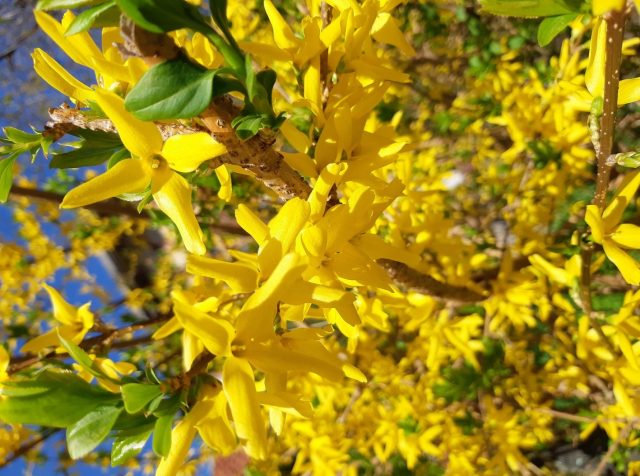
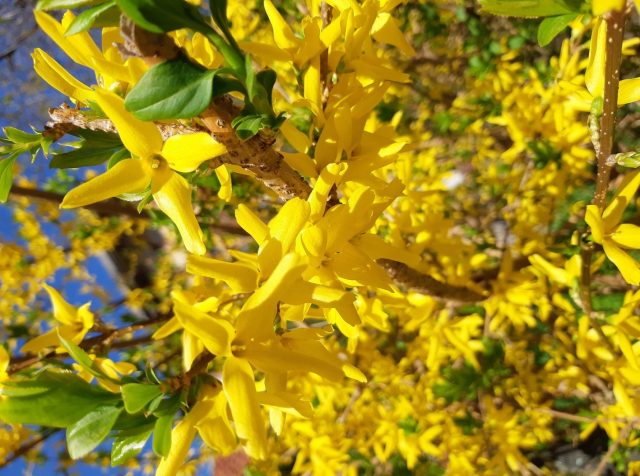
When to carry out the procedure
How to prune forsythia correctly and when? This issue is equally important, since it also affects flowering. So, if you have very little experience in removing unnecessary shoots, then transfer this procedure to the summer. Once the flowering is over, you can cut the branches. If this is done in the fall, then there is a great risk of removing last year’s shoots, and then the buds will not bloom in the spring.
Pruning forsythia in summer means cutting out branches that over-thicken the center to form a bush. In the future, the procedure is only necessary to maintain its decorative form, if the shoots are knocked out of it. Pruning forsythia in the fall is carried out as a way to remove excess and damaged branches.
But this procedure doesn’t have to be intense, so don’t get carried away. Cutting off a large amount of growth, even if it is superfluous, will weaken the plant before the long winter. Another important rule regarding the question of how to prune forsythia for the winter is that the event should be carried out in early autumn so that the sections have time to heal.
How to prune forsythia correctly and when? This issue is equally important, since it also affects flowering. So, if you have very little experience in removing unnecessary shoots, then transfer this procedure to the summer. Once the flowering is over, you can cut the branches. If this is done in the fall, then there is a great risk of removing last year’s shoots, and then the buds will not bloom in the spring.
Pruning forsythia in the fall is done as a way to remove excess and damaged branches. But this procedure doesn’t have to be intense, so don’t get carried away. Cutting off a large amount of growth, even if it is superfluous, will weaken the plant before the long winter. Another important rule regarding the question of how to prune forsythia for the winter is that the event should be carried out in early autumn so that the sections have time to heal.
